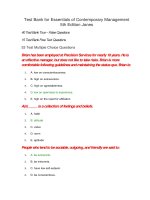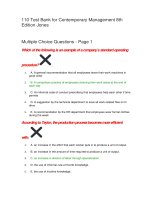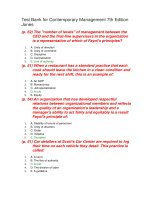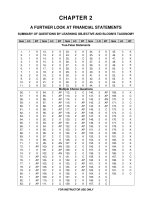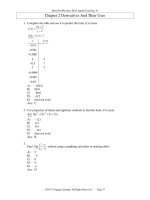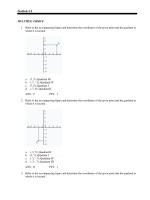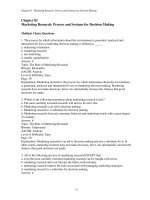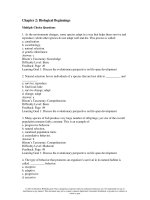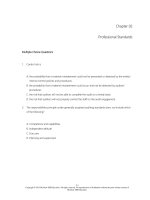Contemporary management 6th edition jones test bank
Bạn đang xem bản rút gọn của tài liệu. Xem và tải ngay bản đầy đủ của tài liệu tại đây (161.24 KB, 64 trang )
Chapter 02 - The Evolution of Management Thought
Chapter 02
The Evolution of Management Thought
TEST PLANNING TABLE FOR CHAPTER 2
Learning Goal
Easy
Moderate
Hard
1. Describe how the need to increase
organizational efficiency and
effectiveness has guided the evolution of
management theory.
3, 38
1, 2, 4
2. Explain the principle of job
specialization and division of labor, and
tell why the study of person-task
relationships is central to the pursuit of
increased efficiency.
3. Identify the principles of
administration and organization that
underlie effective organizations.
5, 39, 40
6, 7, 8, 41,
42, 43
101, 102, 103
9, 10, 11, 13,
14, 18, 21,
44, 45, 46,
47, 48, 53,
54, 55, 59,
62, 63, 64
12, 15, 16,
17, 19, 20,
22, 49, 56,
65, 66, 67,
69, 70, 72,
73, 105
50, 51, 52,
57, 58, 60,
61, 68, 71,
74, 102, 104,
106, 107
4. Trace the changes in theories about
how managers should behave to motivate
and control employees.
27, 29, 75,
76, 77, 79,
80, 81, 82
23, 24, 25,
26, 28, 30,
31, 78, 83,
85
84, 102, 108,
109
5. Explain the contributions of
management science to the efficient use
of organizational resources.
6. Explain why the study of the external
environment and its impact on an
organization has become a central issue
in management thought.
32, 86, 87, 88 33, 110
34, 89, 91,
92, 93, 94,
95, 96
Total number of test items: 112
True/false questions are in plain text.
Multiple choice questions are in bold text.
Short answer questions are in bold underlined text.
2-1
35, 36, 37,
90, 99, 112
97, 98, 100,
111
Chapter 02 - The Evolution of Management Thought
True / False Questions
1. The development of mass-production manufacturing is attributed to production line
workers at Ford Manufacturing.
True False
2. Ford Manufacturing moved from small batch production to mass-production manufacturing
to increase quality.
True False
3. The development of "lean manufacturing" is attributed to an engineer at Toyota.
True False
4. The idea of "lean manufacturing" relies on workers performing narrow, specialized tasks.
True False
5. The process by which division of labor occurs is known as job specialization.
True False
6. Scientific management theory holds that the most efficient division of labor can best be
determined by intuitive knowledge.
True False
7. According to the principles of Scientific Management, the way to create the most efficient
work system was by having workers perform both more tasks and more complex tasks.
True False
2-2
Chapter 02 - The Evolution of Management Thought
8. Scientific management caused many workers to distrust management.
True False
9. The system of task and authority relationships that control how employees use the
organization's resources to achieve the organization's goals is known as the organizational
structure.
True False
10. Max Weber described a system of administration designed to insure both efficiency and
effectiveness that is called "bureaucracy".
True False
11. The power to hold workers accountable for their actions and to make decisions about the
allocation of organizational resources is known as authority.
True False
12. In a bureaucracy, the authority of a manager should be based on the personality and social
status of that manager.
True False
13. Formal, written instructions that specify what workers should do on the job are called
rules.
True False
14. Specific written instructions as to how workers should perform an aspect of their work
task are known as SOPs.
True False
2-3
Chapter 02 - The Evolution of Management Thought
15. Norms are written, formal codes of conduct which prescribe how workers should act in
particular situations.
True False
16. According to Fayol's principles, workers should be given fewer job duties to perform and
should be encouraged to assume less responsibility for their work outcomes.
True False
17. Fayol believed that "dual command" should be encouraged within organizations.
True False
18. The line of authority that depicts the authority of managers at the top over employees at
the bottom of the organization is called the "chain of command."
True False
19. According to Fayol, the greater the number of levels in the hierarchy of the chain of
command of an organization, the faster the pace of the planning and organizing within the
organization.
True False
20. Fayol believed that authority should be concentrated at the top of the chain of command of
the organization.
True False
21. When authority is decentralized, only managers at the top of the organization make
important decisions.
True False
2-4
Chapter 02 - The Evolution of Management Thought
22. Fayol did not recommend the use of organizational charts to show the position and duties
of managers within the organization.
True False
23. The French expression that refers to shared feelings of comradeship and enthusiasm is
"laissez faire".
True False
24. Peters and Waterman's In Search of Excellence identified three major principles to guide
managers. These three principles contradict Fayol's principles.
True False
25. In the Hawthorne studies, researchers found that as they raised and lowered the level of
illumination, the workers' productivity decreased.
True False
26. The Human Relations movement arose prior to the development of Scientific
Management.
True False
27. An "informal organization" consists of the rules and norms that emerge within a work
group.
True False
28. Theory Y assumes that workers are lazy, dislike work, and will try to do as little work as
possible.
True False
2-5
Chapter 02 - The Evolution of Management Thought
29. Theory Y assumes that workers are not lazy, do not dislike work, and will do what is good
for the organization.
True False
30. Fayol's approach to administration more closely reflects the assumptions of Theory X than
Theory Y.
True False
31. Hewlett-Packard is an organization that is committed to Theory X management.
True False
32. Management science is a more modern extension of the ideas of scientific management.
True False
33. The use of information technology detracts from the usefulness of management science
approaches.
True False
34. When an organization ignores its external environment, it has a tendency to dissolve and
disintegrate and entropy can result.
True False
35. A mechanistic structure typically rests on Theory Y assumptions, while an organic
structure typically rests on Theory X or Theory Z assumptions.
True False
36. Typically, managers who work in a mechanistic structure can react more quickly to
change than managers who work in an organic structure.
True False
2-6
Chapter 02 - The Evolution of Management Thought
37. McDonald's operates using an organic structure.
True False
Multiple Choice Questions
38. The manufacturing system that uses small teams of workers on a moving assembly line is
called:
A. NUMMI
B. Small batch production
C. Mass production manufacturing
D. Lean production
E. Automation
39. Who founded the early study of management thought which became known as scientific
management?
A. Elton Mayo
B. Frank Gilbreth
C. Max Weber
D. Henri Fayol
E. F.W. Taylor
40. Early "time-and-motion" studies were an important part of the work of:
A. Elton Mayo
B. F.W. Taylor
C. William Ouchi
D. Daniel Katz
E. Lawrence & Lorsch
2-7
Chapter 02 - The Evolution of Management Thought
41. One way Henry Ford dealt with the problem of workers not working up to their potential
was:
A. Strict discipline
B. Moving conveyor belts
C. Rewards for performance
D. More frequent breaks for workers
E. Better lighting
42. Which of the following was NOT part of "Fordism"?
A. Checking on how employees lived
B. Doubling wages
C. Cutting back on work hours
D. Not permitting employees to talk while on the line
E. All of these were part of Fordism
43. The Gilbreths are best known for their studies of:
A. Fatigue
B. Work movements
C. Human relations
D. Management science
E. Both fatigue and work movements
44. The power to hold workers accountable for their actions and to make decisions about the
use of organizational resources is known as:
A. Power
B. Job specialization
C. Authority
D. Behavioral management
E. The Hawthorne effect
2-8
Chapter 02 - The Evolution of Management Thought
45. Which of the following gives managers the right to direct and to control their subordinates
in order to attempt to accomplish organizational goals?
A. The Hawthorne effect
B. Bureaucracy
C. Esprit de corps
D. Authority
E. Discipline
46. Formal, written instructions which specify what workers should do on the job under
different conditions are known as:
A. Rules
B. Norms
C. Informal organizational understandings
D. Standard operating procedures
E. Bureaucratic control
47. Specific written instructions as to how a worker should perform an aspect of his or her
work task are known as:
A. Norms
B. Standard operating procedures
C. Job specialization
D. Unity of command
E. Centralization
48. Unwritten, informal codes of conduct which prescribe how workers should act in specific
work situations are known as:
A. Rules
B. Standard operating procedures
C. The chain of command
D. Norms
E. Contingency theory
2-9
Chapter 02 - The Evolution of Management Thought
49. When a factory has a standard practice that each machine operator should leave his or her
work station in a clean condition and ready for the next shift of workers, this is an example
of:
A. An SOP
B. Bureaucracy
C. Job specialization
D. A rule
E. Equity
50. A sales organization's employee manual states that standard practice is that salespeople
who call on customers on construction sites should wear a "hard hat" at all times during this
sales call. This is an example of:
A. A norm
B. A rule
C. A guideline
D. Theory X
E. Theory Y
51. Mamma Mia's Ristorante has an informal practice in which all the servers try to help each
other out if they are not busy with customers. This practice is called:
A. Job specialization
B. A rule
C. Unity of direction
D. A norm
E. An open system
52. MegaMart store has a "greeter" at the front entrance who is required by the store to
"welcome all customers with a smile." This practice is called:
A. A norm
B. The line of authority
C. A rule
D. Synergy
E. Integration
2-10
Chapter 02 - The Evolution of Management Thought
53. "Informal authority" can result from:
A. Technical knowledge
B. Moral character
C. Job expertise
D. The ability to lead
E. All of the above
54. The idea that every worker should receive orders from only one superior is called:
A. Line of authority
B. Unity of command
C. Centralization
D. Equity
E. Initiative
55. The "chain of command" which describes the reporting relationships of managers from
the top to the bottom of the organization is known as:
A. The line of authority
B. Discipline
C. Unity of direction
D. Unity of command
E. Initiative
56. According to Fayol, the greater the number of levels in the management hierarchy, the
__________ communication takes between managers at the top and bottom of the
organization and the __________ the pace of planning and organizing.
A. Longer; faster
B. Longer; slower
C. Shorter; faster
D. Shorter; slower
E. None of the above.
2-11
Chapter 02 - The Evolution of Management Thought
57. The Director of Athletics at Whassamatta University reports jointly to both the Dean of
Faculty and the Dean of Student Affairs. This is a violation of which one of Fayol's
principles?
A. Equity
B. Unity of command
C. Unity of direction
D. Initiative
E. Order
58. The "number of levels" of management between the CEO and the first-line supervisors in
the organization is a representation of which of Fayol's principles?
A. Unity of direction
B. Line of authority
C. Discipline
D. Order
E. Initiative
59. When authority is concentrated at the top of the organizational chart instead of being
distributed throughout the management hierarchy, we say that __________ has occurred.
A. Decentralization
B. A bureaucracy
C. Centralization
D. Scientific management
E. Job specialization
60. If the CEO has a long-range strategic plan for the organization and the Marketing
department has its own five-year strategic plan, but these plans are not coordinated, this is a
violation of Fayol's principle of:
A. Order
B. Discipline
C. Unity of command
D. Unity of direction
E. Stability of tenure of personnel
2-12
Chapter 02 - The Evolution of Management Thought
61. A CEO who spends a great deal of time working with executives to develop a five-year
strategic plan for the organization is acting most consistently with Fayol's principle of:
A. Unity of command
B. Equity
C. Unity of direction
D. Discipline
E. Order
62. "Organizational charts" are a representation of which of Fayol's principles of
management?
A. Equity
B. Discipline
C. Order
D. Initiative
E. Stability of tenure of personnel
63. The ability of workers to act on their own, without supervision by a manager, is known
as:
A. Discipline
B. Unity of command
C. Initiative
D. Order
E. The Hawthorne effect
64. Obedience to a manager's request, along with other signs of respect for the manager's
authority, is most consistent with Fayol's principle of:
A. Order
B. Discipline
C. Esprit de corps
D. The chain of command
E. Unity of command
2-13
Chapter 02 - The Evolution of Management Thought
65. An "organization chart" which shows who reports to whom for what is a representation of
which one of Fayol's principles?
A. Centralization
B. Unity of direction
C. Discipline
D. Order
E. Initiative
66. The idea that "managers should encourage employees to be innovative and creative in
their work" is an example of Fayol's principle of:
A. Unity of command
B. Initiative
C. Line of authority
D. Centralization
E. Equity
67. The idea that top management should pay employees in a way that is fair for both the
employees and the organization is an example of Fayol's principle of:
A. Esprit de corps
B. Centralization
C. Remuneration of personnel
D. Unity of command
E. Unity of direction
68. An organization that gives "cash bonuses" to top managers whenever the organization has
an especially profitable year is acting consistently with Fayol's principle of:
A. Stability of tenure of personnel
B. Unity of direction
C. Order
D. Initiative
E. None of the above
2-14
Chapter 02 - The Evolution of Management Thought
69. If an organization has a profit-sharing plan in which top executives are able to purchase
the company's stock at a discount whenever the organization has a highly profitable year, this
organization is acting consistently with Fayol's principle of:
A. Unity of command
B. Discipline
C. Line of authority
D. Unity of direction
E. Remuneration of personnel
70. The idea that employees who stay with the organization for many years develop skills on
the job which can help the organization to become more efficient is consistent with Fayol's
principle of:
A. Equity
B. Order
C. Initiative
D. Discipline
E. Stability of tenure
71. The idea that workers should be aware of how their behavior affects the performance of
the organization as a whole is most consistent with Fayol's principle of:
A. Equity
B. Subordination of individual interests to the common interest
C. Remuneration of personnel
D. Unity of direction
E. Stability of tenure of personnel
72. When a manager asks a subordinate to consider how his or her actions are impacting the
entire organization instead of merely focusing on the subordinate's own interests, this
manager is acting on the basis of Fayol's principle of:
A. Equity
B. Initiative
C. Subordination of individual interests to the common interest
D. Remuneration of personnel
E. Stability of tenure of personnel
2-15
Chapter 02 - The Evolution of Management Thought
73. When a manager and his or her subordinates share feelings of comradeship and devotion
to a common cause, they are expressing Fayol's principle of:
A. Unity of command
B. Order
C. Discipline
D. Esprit de corps
E. Laissez-faire
74. Which of the following is NOT one of the contributions of Mary Parker Follett?
A. Managers should act as coaches, not monitors
B. Managers must recognize the informal organization
C. The importance of cross-functional communication
D. Power should flow to the person with the most expertise in any given situation
E. Workers should be involved in job analysis
75. Whose theory holds that, "Authority should go with knowledge...whether it is up the line
or down"?
A. Follett
B. Weber
C. Hawthorne
D. Fayol
E. Taylor
76. The research studies which experimented with different levels of lighting and its impact
on worker performance and fatigue are known as:
A. The Fayol studies
B. The Taylor studies
C. The Hawthorne studies
D. The Katz studies
E. The Weber studies
2-16
Chapter 02 - The Evolution of Management Thought
77. Which management theory advocates that supervisors be trained to manage subordinates
according to behavioral principles in order to achieve the cooperation of these subordinates
and, thereby, to increase their productivity?
A. Scientific management
B. Equity theory
C. The Hawthorne studies
D. Human relations movement
E. TQM
78. One of the main implications of the Hawthorne Studies was that:
A. Illumination affects workers' productivity
B. Illumination effects workers' satisfaction
C. Workers' feelings and thoughts can affect performance
D. A group will perform at a level lower than its members working individually
E. Management is unnecessary
79. The system of rules of behavior that emerge as a group of workers get to know one
another by working together is known as:
A. An informal organization
B. A code of conduct
C. Scientific management
D. A formal organization
E. None of the above
80. The study of the factors that have an impact on how workers respond to one another
within organizations is known as:
A. The Hawthorne studies
B. Organizational behavior
C. Unity of command
D. Scientific management
E. Organic structure
2-17
Chapter 02 - The Evolution of Management Thought
81. Managers who accept the assumptions of Theory X:
A. Focus on developing SOPs
B. Develop a well-defined system of rewards and punishments
C. Give little autonomy to workers to solve problems
D. Focus on developing rules
E. All of the above
82. Managers who accept Theory Y:
A. Create a work setting that encourages commitment
B. Give little autonomy to workers
C. Focus on developing rules and procedures
D. Rely on rewards and punishments
E. None of the above
83. If a manager feels that his major job responsibility is "to counteract the natural tendencies
of subordinates to avoid working hard," this manager is acting consistently with the principles
of:
A. Contingency theory
B. Theory X
C. Theory Y
D. Theory Z
E. Management science theory
84. If a manager feels that her responsibility is to create a work setting in which her
subordinates consider their work to be satisfying, she is acting consistently with the principles
of:
A. Theory X
B. Theory Y
C. Contingency theory
D. Management science theory
E. Scientific management theory
2-18
Chapter 02 - The Evolution of Management Thought
85. The HP Way emphasizes:
A. Vertical communication
B. Formality among management and workers
C. Following rules
D. Secrecy
E. Team atmosphere
86. The management theory that focuses on the use of rigorous, quantitative techniques that
are intended to assist managers to make the best use of organizational resources is called:
A. Contingency theory
B. Management science theory
C. Administrative management theory
D. Behavioral management theory
E. Human relations theory
87. The aspect of management theory that uses mathematical techniques such as modeling
and simulation to help managers to make better decisions is called:
A. Behavioral management
B. Contingency management
C. Quantitative management
D. Administrative management
E. Human relations management
88. The aspect of management theory that analyzes production systems to increase efficiency
is:
A. Contingency management
B. TQM
C. Operations management
D. Scientific management
E. Human relations management
2-19
Chapter 02 - The Evolution of Management Thought
89. The collection of forces that exist beyond the organization's physical boundaries but
which affect the manager's ability to obtain and to use resources is known as:
A. The organizational environment
B. The administrative environment
C. The Hawthorne effect
D. The informal organization
E. The open system
90. The theory (-ies) that describe the impact of external forces on the organization is(are)
called:
A. Scientific management
B. Management science
C. Administrative management
D. Organization-environment theory
E. The human relations movement
91. A system which takes resources from its external environment and converts them into
goods that are then sent back into that environment is known as:
A. A conversion system
B. An output system
C. An input system
D. An open system
E. A behavioral system
92. The stage of a system during which the organization obtains resources such as raw
materials and labor in order to produce goods is known as:
A. The conversion stage
B. The behavioral stage
C. The output stage
D. The open stage
E. The input stage
2-20
Chapter 02 - The Evolution of Management Thought
93. The stage of a system during which the organization transforms raw materials into
finished goods outputs such as automobiles or French fries is known as:
A. The input stage
B. The behavioral stage
C. The open stage
D. The conversion stage
E. The output stage
94. The stage of a system during which the organization releases finished goods inventory to
the external environment so that customers can purchase these goods is known as:
A. The input stage
B. The conversion stage
C. The output stage
D. The open stage
E. The behavioral stage
95. The idea that the effectiveness of organizational structure and control systems depends on
what outside forces it is facing is called:
A. Behavioral management
B. Contingency management
C. Quantitative management
D. Administrative management
E. Human relations management
96. The concept that: "There is no one best way to manage" is a fundamental premise in:
A. Scientific management theory
B. Administrative management theory
C. Contingency theory
D. Behavioral management theory
E. The human relations movement
2-21
Chapter 02 - The Evolution of Management Thought
97. A top manager recognizes that her organization's markets are highly volatile because the
actions of competitors are very difficult to predict accurately. In response, she tries to create
an organization that is very flexible and can react quickly. Which principle is she following?
A. Open systems theory
B. Situational leadership theory
C. Contingency theory
D. Bureaucracy theory
E. Scientific management
98. Juanita alters her management style depending on the particular issue with which she is
dealing. She is acting consistently with the principles of:
A. Management science theory
B. Contingency theory
C. Theory X
D. Administrative management theory
E. A bureaucracy
99. ABC Company's external environment is changing rapidly and it responds by
decentralizing decisions to lower-level managers so that the organization can react faster.
ABC is said to be organized under:
A. A mechanistic structure
B. A centralization structure
C. A behavioral management structure
D. A human relations structure
E. An organic structure
100. Managers at Acme Explosives supervise workers closely and use rewards and
punishments to control their behavior. Acme is a ________ organization.
A. Bureaucratic
B. Organic
C. Efficient
D. Mechanistic
E. Behavioral
2-22
Chapter 02 - The Evolution of Management Thought
Essay Questions
101. F.W. Taylor, in his study of what came to be called scientific management, developed
four principles which were intended to increase worker efficiency on the job. Discuss any two
of these four principles and explain how each of them could be applied to workers in an
automobile assembly line.
102. Choose any three of the following management contributors: Taylor, Fayol, Weber,
Follett, the Gilbreths. Briefly discuss (1) at least two of their major contributions and (2) how
these contributors have influenced today's organizations.
103. Discuss the impact of Taylor's and the Gilbreths' work on the working lives of factory
employees. What "games" did managers and workers engage in?
2-23
Chapter 02 - The Evolution of Management Thought
104. Max Weber developed five principles as to how work should be organized within a
bureaucracy. Select any two of these principles and discuss how a manager would behave in a
factory if that manager were trying to follow each of the two principles which you have
selected.
105. Max Weber's principles of management theory within a bureaucracy have had a great
impact upon the management actions of many large organizations. Discuss three
disadvantages of management under a bureaucracy in terms of what can result if the
principles are not applied in an appropriate manner.
106. Some organizations design reporting relationships in which an employee reports to two
superiors instead of to only one superior. As a result, this employee may have access to two
managers who have different skills and expertise. Such a practice, however, can easily create
serious problems for the employee. Discuss three of these problems that can occur under this
management structure and explain why a reporting relationship to a single superior is a better
way to design an organization.
2-24
Chapter 02 - The Evolution of Management Thought
107. Centralization versus decentralization is one of the more interesting arguments in
management theory. Discuss the pros and cons of each of these two organizing methods in
terms of how a large organization can be organized in terms of its decision-making authority.
108. The Hawthorne studies had a great impact on the early study of management theory.
Discuss these studies in terms of how they were designed and in terms of the results which
were helpful to developing a better understanding of how managers should behave in the
workplace.
109. Managers who accept the assumptions of McGregor's Theory X are likely to design a
very different work situation than managers who accept the assumptions of Theory Y. Discuss
how managers who are committed to Theory X assumptions are likely to organize their work
environment in terms of their relationships with their subordinates.
110. Identify and explain the branches of management science.
2-25
